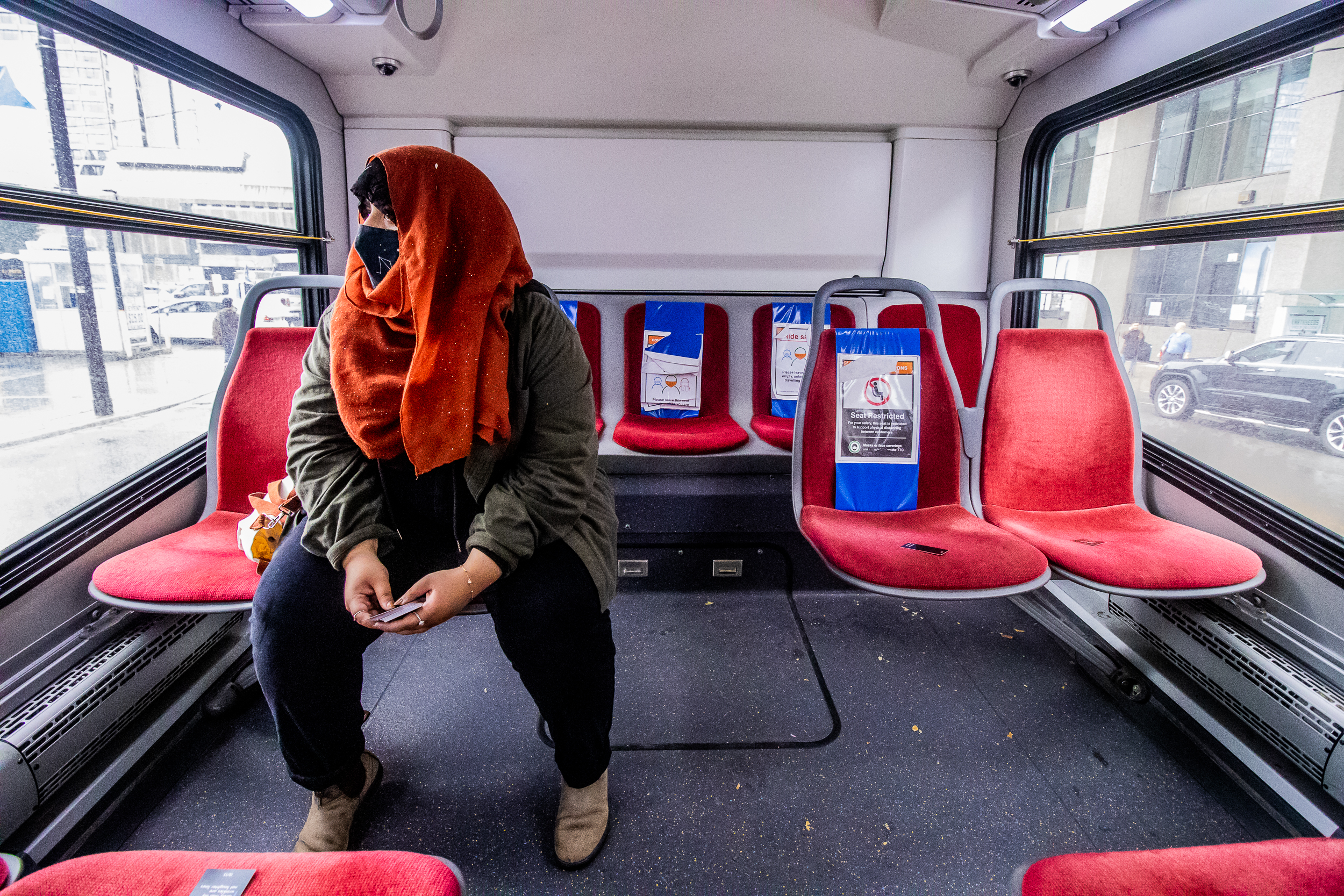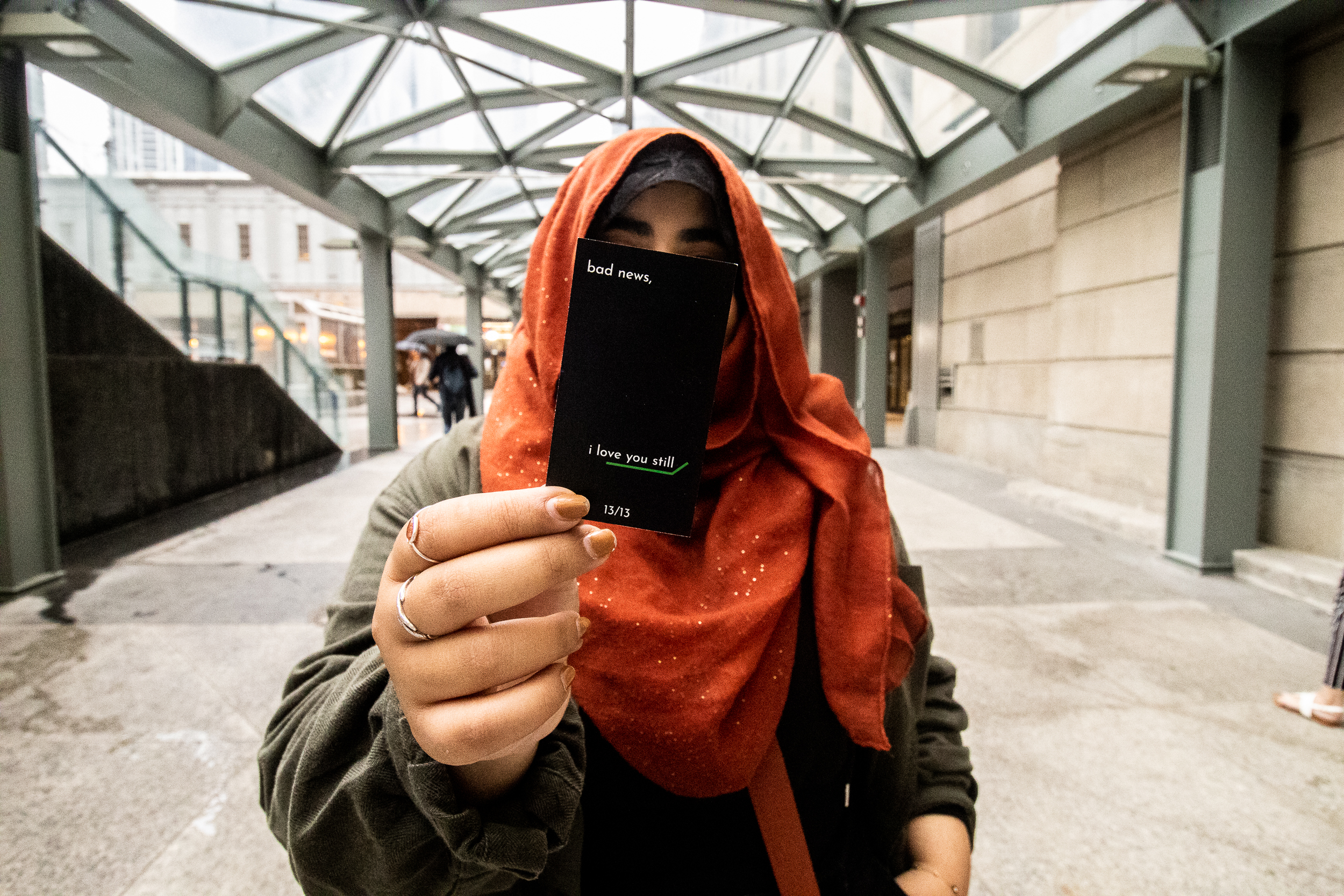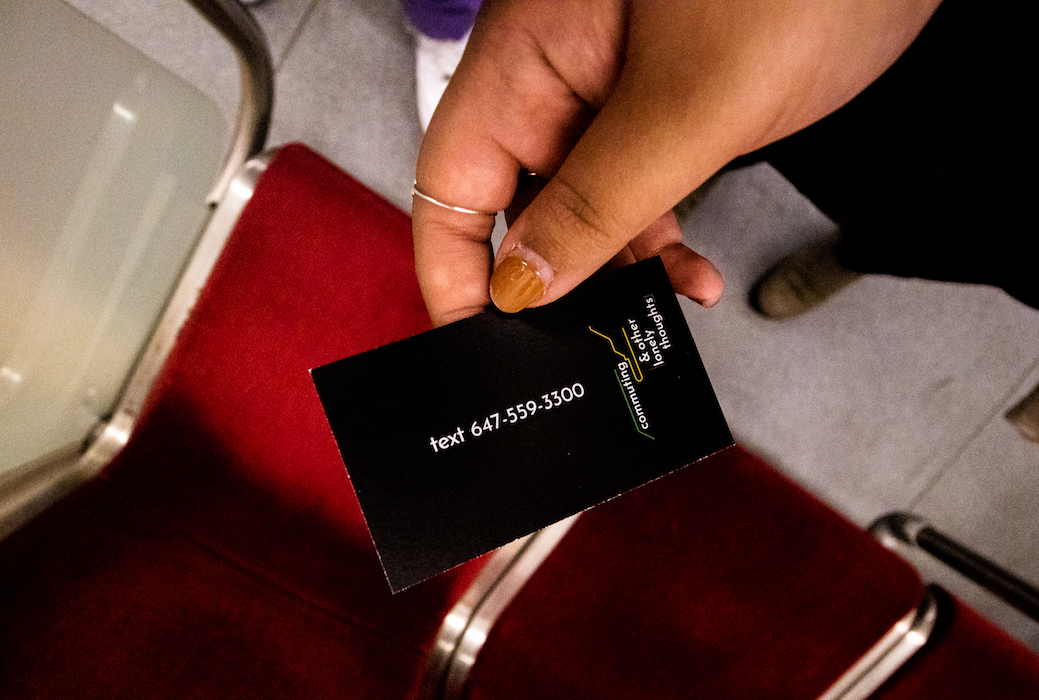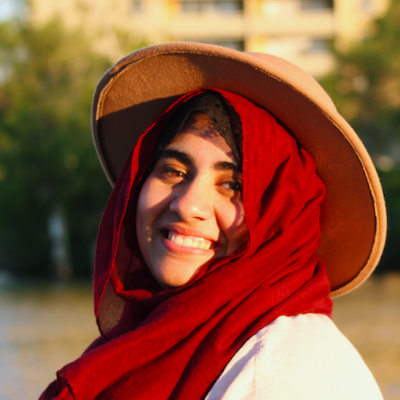Commuting and Other Lonely Thoughts: An Interview With Artist Yasmeen Nematt Alla
With Commuting and Other Lonely Thoughts, artist Yasmeen Nematt Alla extends an invitation, sent by text: “Can you tell me a bit about your loneliness? I promise to tell you about mine in return.” As part of the STEPS CreateSpace Public Art Residency, the project distributed the live phone number on cards and posters across Toronto’s public transit system, accompanied by prompts like, “We’re never going to see each other again, are we?” Commuters all over the city texted the number, anonymously sharing moments of loneliness, passing thoughts, wishes, suspicions, or sometimes rants.
Yasmeen Nematt Alla’s artistic practice is thoughtful, sensitive, and always engaged with care. Commuting and Other Lonely Thoughts reflects this with a small gesture of care at its core: a card waiting on your seat on the bus, an offer to make you feel less alone. In our interview, the artist discusses how people responded to the work, and how public art that facilitates a moment of pause can be reflective, emphatic, and even radical.

Photo credit: Selina McCallum
Eva Morrison: A lot of your work revolves around feelings of isolation, grief, and loneliness, which I think ties into the pandemic. Commuting and Other Lonely Thoughts is so relevant in that context; there’s that need for human connection that’s really felt by everybody right now. When you were working on this project and thinking through these themes, how did you come up with what you wanted to say on the cards you distributed on the transit system?
Yasmeen Nematt Alla: I found myself thinking this is definitely going to be a project about subways, about transitioning, about transit systems, but also about the ways we are in transition…I had asked a bunch of my friends: “Hey, take subway rides, take buses, take GO buses, and type in your notes apps whatever thoughts that come and just send them to me.” I just asked I think 15 people to do that…and the responses always varied; some of them were completely nonsensical, some were funny, and some were just like, “Oh, I’m so bored.”
And then I did the same exercise across a week: just notating my thoughts as I go into the subway and as I leave it…depending on the time of day, depending on where I was going, depending on what was going on that day specifically, the thoughts varied.
I’m just always so curious about the people who come on to subways and the people who leave them. I think a lot about stories where people fall in love with others on their commutes, people they’re never gonna meet again. I love imagining seeing someone sitting across a seat from you and being like “this person could potentially be someone that is dear to my life…And I’ll never know because we’re not talking to each other, or we can’t, or we shouldn’t.”
I love those intersections of: what if the person that is dear to you got off the stop right before the one you got on…what if we just never cross paths because we are never at the same stop at the right time?
EM: I love those missed connections.
YNA: Yeah me too, I’m such a sucker for missed connections.*laughs*
That’s a bit of that mindset of how those phrases came to be and how the questions came to be.
And the phrases function as an invitation, right? Like I’m asking a big ask. I’m asking someone to not only text a random number they found on a subway, but I’m also asking them to be very vulnerable with me. And I think in that sort of emotional labour, there is a sort of exchange that has to happen with the artist. And when they see that piece of text on the card I want for that to be the first part of the exchange: here’s a piece of my loneliness, can you tell me some of yours? and have it function in that sort of manner.
EM: I think it’s so interesting to position that exchange on public transit because we’re physically close but we’re isolated at the same time, and there are those ambiguous interrelations. Some cards really built on that anonymous element, how forming a connection by texting an unknown number kind of reflects the space of the commute. From your perspective, how did you find that anonymity, like speaking into a void almost, informed people’s responses?
YNA: I really love the notion of anonymity; we find comfort in anonymity. I am a product of Tumblr communities, where people know your deepest secrets, but not your name… so a lot of my projects really celebrate the notion that connection isn’t necessarily rooted in basic knowledge about oneself.

Photo credit: Selina McCallum
It was interesting because there were a couple of kinds of reactions. You had people who found a lot of comfort in the whole [sense that] “now I can tell someone something.” And a lot of the text messages were so heartbreaking and so vulnerable and just folks being like: “I’ve never told this anyone to anyone before, but I feel like my friends don’t love me” or messages like: “I feel like if I get on this bus right now and leave, no one’s gonna know that I’m gone.”
But then you got like a bunch of other messages like: “I wish this was a real person”, or “I wish I can talk to you for real” from people who were craving something even beyond that anonymity, which actually surprised me because I take a lot of comfort in anonymity in general. I feel like I can, like you said, just speak to the void and find myself wanting to tell it everything. Because it’s so much easier to tell a stranger your deepest thoughts than someone who knows you and can judge you for them.
So it was so intriguing to find that some people actually hated the anonymity bit! It functioned in both ways where it was comfortable for some and then angering for others, and those are both very wonderful, vulnerable reactions that fill the rubric.
That’s more than I could have hoped for, because you hope that the project fulfills the thesis statement that you’ve set for it at the beginning, but then it’s always really nice when you’re completely surprised by the things that you put out in the world. To have people show anger that they can’t connect in much more visceral manners is exciting, and it’s just evidence that we don’t actually have spaces to connect with one another. We don’t have spaces to find each other. In whatever small gesture it offers to have a number that you can just message and see what happens from there, it’s really intriguing that the answer to that for some folks is like, I wanna ask for more than just this automated number that gives me an automated message…even though it could be a thoughtful message, it’s still not enough because it’s not an actual person.
EM: Getting that range of responses then does feel like it was successful, that it prompted a lot of different people to express what their needs were and reflect how a gesture like that can really bring up what’s missing, and that’s a small starting point right?
YNA: One hundred percent. These projects, because they’re so community and collective driven, you can never begin to suspect what you’re gonna get. You get a range of folks wanting to be vulnerable, and then a range of folks worried that this might be some sort of collection of information and asking about advertising, and then some folks asking if they could donate somewhere.
People are starving for connection. You know, it’s such an obvious thing because yes, of course, we’re starving for connection, but I think there is nuance even in that statement… I don’t think we’re just starving for any connection, I think we’re starving for spaces where we can tell our deepest, most tragic stories that function under capitalistic white supremacist systems, the way we can’t exist under them, the way we’re crumbling under them. But you can’t tell that to your day-in and day-out relationships, so maybe you can tell it to this random number that you find on the subway. *Laughs*
EM: Exactly. And I appreciate that you’re really aware of the exchange of emotional labour that happens. Maybe there’s also a sense that it is on their own terms when people are responding to this because there’s a control in your own anonymous response: even if it’s vulnerable, you’re sending from your own phone.
YNA: I also think it’s really important to recognize that I exist as a very specific kind of human being; when people look at me, they come with their own biases and their own understandings of who I am—for the good and for the bad. There is something to be said about bearing yourself and not assuming that you’re going to be judged for it based on who you are, not having to do the sort of code-switching that we have to do with folks because of who they are. Like I’m a woman of colour: the way I talk to other women of colour is gonna be completely different than how I would talk to someone who does not share that identity.
So I’m really interested in my function as an artist, not necessarily to erase myself in that way, because I’m still offering a piece of myself, but to almost allow them to exist as who they are, not what I expect them to be, because I too come into all conversations with certain biases and assumptions that I can’t escape.
But it’s an interesting back and forth and a negotiation that you kind of have to do; anonymity functions in a very specific way when it comes to exchange of labour and emotions and sometimes it’s a slippery slope and maybe even a space for toxicity…but what if it was used as an escape? What if it was used as safer spaces? And sometimes you get folks who really needed that space and sometimes you get folks who hated it, and that’s really cool either way.

Photo credit: Selina McCallum
EM: And for the conversations where you felt like there was that real need for a connection, was there a prompt that people tended to gravitate towards or a direction people went with it? Could you share what your takeaways were?
YNA: I think it’s just that people are lonely, I think that was the common thing. The prompt is very much trying to lead you towards you telling it why you’re lonely or [about] something that is making you lonely. But also, there’s no universal understanding of loneliness. It’s not a very rooted feeling the way anger is or joy is…loneliness is so specific, but also extremely generic, which is a very intriguing contradiction in an emotion.
Sometimes people are talking about loneliness because they’re experiencing heartbreak. And sometimes they’re talking about loneliness because they’re actually searching for love and they can’t necessarily find it. Sometimes the relationships in their lives are not necessarily satisfying them in the ways that they think they should be satisfied with them.
I had multiple variations of folks being like “I left home and I think it was a mistake and I should have never left.” And having folks being like, “I really thought that you were the one” and then that’s the whole message and it’s so gut-wrenching. That’s all that’s needed to be said because of course that is one of the loneliest thoughts ever.
I wish I could give you a very straight answer like, this is what everyone has been talking about, this was the hot topic. *laughs* But I just keep finding myself getting responses that are new every single time.
EM: Right, because loneliness is felt in so many different facets. Especially in the circumstances we’re living with in the pandemic, a lot of people had so much loss this year, which is also felt in many ways: losing control, losing people, losing connections, losing your job, your lifestyle…and it kind of creates this collective sense of grief and loneliness. I think it really is palpable in public spaces and cities, and especially in those places which are regulated by certain systems that keep us isolated. So with a project that touches on that, what do you think is the role of public art in this context?
YNA: I think that the way public art has pulled me has always gone back to the idea of artistic practice never belonging inside “the white cube.” Traditional fine art spaces are classist and elitist productions; ones that make people feel unworthy of entering galleries. They feel they won’t get it, like they’re uneducated, “not smart enough”, or it’s too beyond them. Often however, the art of the white cube is its own language, one that we fail as artists to translate effectively due to our privilege as learned speakers. I need to be of a certain privilege in order to have time to go to a gallery and see the new show that’s up and even more privilege to have the means and time to develop the language for it…most folks, primarily Black and Brown communities, aren’t afforded that privilege due to a classist colonial white supermacist system that was never created for them in the first place.
And then it becomes a conversation of: what can public art offer that serves the folks that are really important to us, who are our communities? Making, storytelling, and oral histories are collective endeavours that have been used as means of revolution by said communities, as means of community-building for centuries. This is how we tell accessible stories, this is how we build upon each other’s narratives.
These practices have always been a form of artistic practice and to pretend that art has always belonged in galleries is an erasure of these histories, of Black histories, Indigenous histories, and POC histories that are completely rooted in art as creation and storytelling and shared legacy. And I think public art—and not to put too much pressure on it as a concept—but I do think it serves a lot of these conversations in a very effective manner.
Something as simple as a mural is going to make you stop on the street and look at it and you won’t have to pay a dime. Suddenly you are encountering something beautiful or intriguing or captivating, and it’s made you pause. And I think that the biggest action of revolution under a capitalistic system is to pause. In a world that is requesting us to just do the next thing as fast as possible and to produce at inhumane levels, it is an act of radicalism to choose to not do that.
Public art often asks you to slow down in a way that I’ve always appreciated. When I started working on this project, I think it was about self-reflection; that I was lonely and I wanted to talk to other people that were also lonely. But it was also about the fact that we go so fast because the systems we work under require us to, we forget that this isn’t sustainable.
A public art piece showcases that you are worthy of slowing down and telling your story, that you are worthy of something beyond the classist nature of the consumption of art, and your jobs, and your next paycheck, and your next contract, and the families that you need to be serving, et cetera…outside of all of that, you are still worthy of just stopping. I think public art does that for people. It tells them that they’re worthy of time, which is something that we’re made to believe we don’t have much of.
EM: Absolutely. And current situations really brought to light and brought under scrutiny this idea of the luxury of taking a pause, and what it means to have access to time to think. So the project that you’ve put together is such a nice way to invite that pause on a system that is accessible; everybody is on public transit, and maybe it doesn’t take too long to take that reflection and send a text and make a connection.
YNA: Thank you. I really appreciate that. The cohort that I’m in is really brilliant and folks made such beautiful, beautiful work. But my work is always very small gesture work, like sending mail and playing with coins. So I had a bit of an existential crisis at the beginning of the project, like I guess I’m gonna have to make something big and permanent.
And then halfway through, I was like, I don’t know how to do that first of all. *laughs* So I’m gonna stick to what I know, which is doing very, very small things in hoping that someone kind of picks it up…
And I’ve been very, very lucky that folks pick it up.
About the Artist

Yasmeen Nematt Alla
Yasmeen Nematt Alla (she/her) is an Egyptian artist and art worker living in Tkaronto, Ontario. Her practice approaches alienated narratives from an interpreter’s perspective. As someone who lives between cultures, she deciphers language barriers attached to alienation and otherness. To keep up with this project and her upcoming work, you can follow Yasmeen Nematt Alla on Instagram.
About the Writer
Eva Morrison (she/her) is a writer, curator, and painter based in Montreal. Her work has recently been published by Culture Days, Winnipeg Arts, and FARR Montreal. She received a BFA from Concordia University in 2019, specializing in Art History and Studio Arts.
Supporters
The 2021 CreateSpace Residency was made possible by support from TD Bank Group through the TD Ready Commitment, the City of Toronto as part of ArtworxTO: Toronto’s Year of Public Art 2021 – 2022, Partners in Art, MAWA, Canada Council for the Arts and funding provided by the Government of Ontario.



